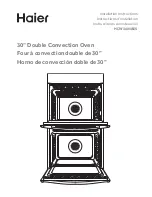
Component Teardown and Testing
4-5
High Voltage Capacitor Testing
1. Check continuity of the capacitor with the meter set at
the highest resistance scale.
2. Once the capacitor is charged, a normal capacitor
shows continuity for a short time, and then indicates
9M
.
3. A shorted capacitor will show continuous continuity.
4. An open capacitor will show constant 9M
.
5. Resistance between each terminal and chassis
should read infinite.
Figure 4-8. High Voltage Capacitor Removal
6. The output power is obtained by the following
formula:
7. Normal temperature rise for this model is 9.9°C to
10.3°C at ‘HIGH’.
NOTE 1:
Variations or errors in test procedure will cause
a variance in the temperature rise. Additional power test
should be made if temperature rise is marginal.
NOTE 2:
Output power in watts is computed by
multiplying the temperature rise (step 5) by a factor of 91
times the of centigrade temperature.
High Voltage Diode Testing
1. Isolate the diode from the circuit by disconnecting its
leads.
2. With the ohm-meter set at the highest resistance
scale, measure across the diode terminals. Reverse
the meter leads and read the resistance. A meter
with 6V, 9V or higher voltage batteries should be
used to check the front-to back resistance of the
diode (otherwise an infinite resistance may be read
in both directions). The resistance of a normal diode
will be infinite in one direction and several hundred
K
in the other direction.
Main Relay and Power Control Relay
Testing
1. The relays are located on the PCB Assembly.
Isolate them from the main circuit by disconnecting
the leads.
2. Operate the microwave oven with a water load in the
oven. Set the power level set to high.
3. Check continuity between terminals of the relays
after the start pad is pressed.
Summary of Contents for E30MH65GPSA
Page 2: ......
Page 32: ...Component Teardown and Testing 4 14 Notes ...
Page 33: ...Wiring Diagrams 5 1 Wiring Diagram ...
Page 34: ...Wiring Diagrams 5 2 Notes ...
Page 38: ...Parts List 6 4 Notes ...
















































